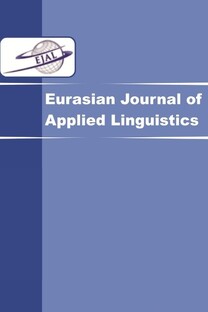Developing ELP Students’ Reading Skills through a Blended Learning Approach
Developing ELP Students’ Reading Skills through a Blended Learning Approach
___
- Adegboye, A. O. (1993). Proficiency in English language as a factor contributing to competency in Mathematics. Education Today, 6(2), 9-13.
- Benrabah, M. (2007). Language in Education Planning in Algeria:Historical Development and Current Issues. In Language Policy. (2007)6; 225-252. Springer.
- Council of Europe. (2001). Common European framework of reference for languages: Learning, teaching, assessment. Cambridge, U.K: Press Syndicate of the University of Cambridge.
- Clark, R. C. (2002). The New ISD: Applying Cognitive Strategies to Instructional Design. ISPI Performance Improvement Journal, 41(7), 10-16. doi:10.1002/pfi.4140410704
- Coleman, H. (2010). The English Language in Development. A paper commissioned by the British Council. Retrieved on Dec 9, 2014 from https://www.teachingenglish.org. uk/sites/teacheng/files/UK011-English-Language-Development.pdf
- Dale, E., &Chall, J. (1995). Readability Revisited: The New Dale-Chall Readability Formula. Cambridge, Massachusetts: Brookline Books Inc.
- Davies, F. (1995) Introducing Reading. London: Penguin Books.
- Denning, J. (2008).Guide to Education Research for Journalists. The Hechinger Institute on Education and the Media at Teachers College, Columbia University. Retrieved from, http://www.articlesbase.com/education-articles/experimental-method-1512721.html
- Department of Education and Training. (2003). Blended Learning, NSW Department of Education and Training.
- Gordon, D. C. (1966). The Passing of French Algeria.London: Oxford UniversityPress.
- Hamzaoui, H., &Lamri, C. (2011). An English course for Algerian Law and Administrative Science students.ESP Across Cultures, 8, 23-43.
- Hans,A.,& Hans,.E.(2013).Role of Computers in Reading Skills. IOSR Journal Of Humanities And Social Science (IOSR-JHSS) Volume 15, Issue 4 (Sep. - Oct. 2013), PP 15-19 e-ISSN: 2279-0837, p-ISSN: 2279-0845. www.Iosrjournals.Org
- Heinze, A., & Procter, C. (2004) Reflections on the Use of Blended Learning, Education in a Changing Environment Conference Proceedings, 13th-14th September 2004.f
- Kotzer, S., & Elran, Y. (2012). Learning and teaching with Moodle-based e-learning environments, combining learning skills and content in the fields of Math and Science & Technology. In Proceeding of 1st Moodle Research Conference (pp. 122-131). Crete-Greece: Heraklion.P122
- Lalima,*., & Kiran, L. D.(2017). Blended Learning: An Innovative Approach. Universal Journal of Educational Research 5(1): 129-136, 2017. DOI: 10.13189/ujer.2017.050116
- Marsh, D. (2012). Blended learning: Creating learning opportunities for language learners. New York: Cambridge University Press.
- Marques, O., Woodbury, J., Hsu, S.,& Charitos, S. (1998). Design and Development of a Hybrid Instruction Model for a New Teaching Paradigm. Proceedings of 28th Annual Frontiers in Education Conference. Moving from 'Teacher-Centered' to 'Learner-Centered' Education, 1, 90-94. doi: 10.1109/FIE.1998.736810 .
- Miliani, M.(2003).Foreign Language Teaching Approaches, Methods and Techniques. Oran: Dar El Gharb.
- Milone, M. (2008). Assessing Reading: Multiple Measures for Kindergarten Through Twelfth Grade. Consortium On Reading Excellence. Califorina. Arena Press.
- Procter, C. (2003). Blended Learning in Practice. In Inaugural Education in a Changing Environment conference. Salford, University of Salford,.
- Tabory, E., & Tabory, M. (1987). Berber unrest in Algeria: lessons for language policy. International Journal of the Sociology of Language, Volume 1987, Issue 63, Pages 63–80, ISSN (Online) 1613-3668, ISSN (Print) 0165-2516, DOI: https://doi.org/10.1515/ijsl.1987.63.63.( 26 January 2016)
- Tesser, C.C. (2005). The Role of Building Reading Comprehension. Retrieved on Nov 3, 2012from, http://apcentral.collegeboard.com /apc/public/repository/Spanish_Lang_.pdf
- Thorne, K. (2003). Blended learning: how to integrate online and traditional learning. London: Kogan Page Limited.
- Victorian Department of Education and Early Childhood Development (DEECD). (2012). Blended learning A synthesis of research findings in Victorian education 2006-2011. Retrieved from, https://www.education.vic.gov.au/documents/about/research/blended learning.pdf
- Watson, J. (2008). Blended learning: The convergence of online and face-to-face education. Vienna, VA: North American Council for Online Learning.
- ISSN: 2149-1135
- Yayın Aralığı: 3
- Başlangıç: 2015
- Yayıncı: Ece Zehir Topkaya
Review of English Language Education Policy in The Middle East and North Africa
Eliciting ELT Students’ Understanding of Plagiarism in Academic Writing
Foreign Language Anxiety and Enjoyment in an Imagined Community
Nahid TALEBZADEH, Majid Elahi SHIRVAN
Developing ELP Students’ Reading Skills through a Blended Learning Approach
Chams Eddine LAMRIA, Hafida HAMZAOUI
The Present State of the Aspect Hypothesis: A Critical Perspective
